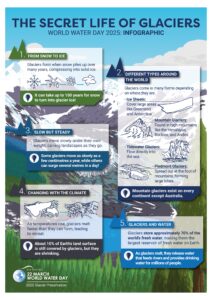
It’s the essence of life, a sustainer and a life force. At any given point in time, it is impossible to imagine life without water.
The compelling need to heighten awareness about this life force drove the United Nations General Assembly to designate March 22nd as World Water Day in the year 1993. Additionally, the main focus is to support the achievement of Sustainable Development Goal (SDG), water and sanitation for all by 2030.
https://www.unwater.org/our-work/world-water-day
Interestingly, this Observance is one of the largest international days, along with Human Rights Day (December 10th), International Women’s Day (March 8th), and the International Day of Peace (September 21st).
Warming and water scarcity: In the last few decades, global warming coupled with an increased demand for water due to rapid urbanization have led to water scarcity— it is estimated that almost 2.2 billion people live without access to safe water and only 0.4% of the world’s drinkable water is currently accessible to humans. https://worldwaterreserve.com/percentage-of-drinkable-water-on-earth/
According to The National Intelligence Council’s report on Global Water Security (2012), by 2040, the global demand for freshwater resources will exceed availability.
Preserving Glaciers
The theme for this year’s World Water Day is ‘Glacier Preservation’. As temperatures rise and the planet gets hotter due to climate change, glaciers are now melting faster than ever and glacial retreat threatens devastation. For billions of people, meltwater flows are changing, causing floods, droughts, landslides and sea level rise, and damaging ecosystems.
How Does Glacial Loss Impact Us
• Glacier mass loss has doubled in the past 20 years, mainly driven by human-induced climate change. Many glaciers in regions like the Andes and Himalayas could disappear by 2100 if current trends continue.
• Glaciers store approximately 70% of the world’s fresh water, making them the largest reservoir of fresh water on Earth. Nearly 2 billion people rely on water from glaciers, snowmelt and mountain run-off for drinking, agriculture, and energy production.
• Increased glacier melting contributes significantly to global sea-level rise, with today’s sea level about 20 cm higher than in 1900.
• Glaciers reflect sunlight due to their bright surfaces, helping to regulate Earth’s temperature. As they melt, this reflective surface shrinks, causing more heat absorption, which accelerates global warming. Limiting global warming to 1.5°C could save glaciers in two-thirds of the world’s heritage sites.
The Panacea
The United Nations has outlined several strategies for mitigating and adapting to the impacts of climate change on glaciers. Some of these include:
• Reducing emissions: The urgent need to reduce greenhouse gas emissions to limit global warming to 1.5°C above pre-industrial levels (The Paris Agreement) is vital to slow the melting of glaciers and reduce the associated risks like rising sea levels, fresh water shortages, floods or landslides.
• Strengthening water resource management: Managing glacial runoff is critical for preventing water shortage and excessive flooding. There is also an urgent need for improved water infrastructure in many areas to store seasonal glacial meltwater, and for countries to improve their water efficiency and reuse systems.
• Ecosystem restoration: Protecting and restoring ecosystems around glaciers helps stabilize water flows, maintains biodiversity, and supports the adaptation of local communities to changing water patterns.
• International cooperation: For countries that share transboundary water resources from glaciers, sharing knowledge, data, and strategies for water conservation is the key towards managing the impact of glacier melt on a regional scale.

